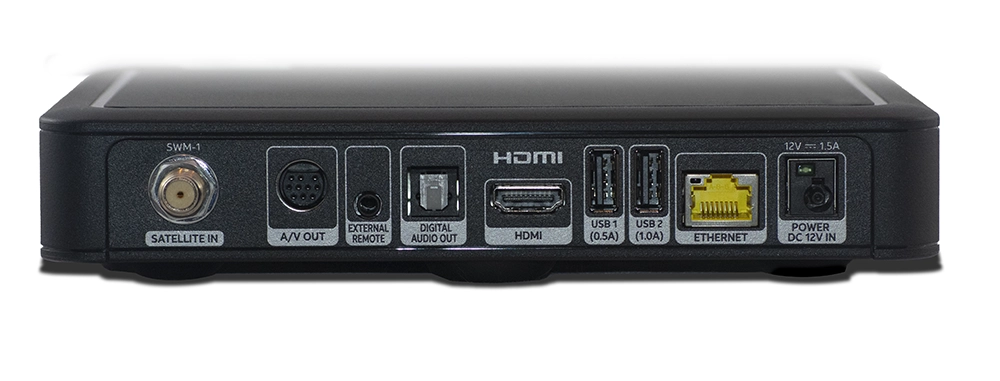Here’s the back of DIRECTV’s H25 receiver. The photo dates from 2011:

In case you’re wondering, the person who took those pictures (it wasn’t me) was doing their best with the consumer equipment they had at the time.
This is the back of DIRECTV’s latest H26K Commercial receiver. I took this picture in the using a pro-quality camera with proper studio lighting.

Notice anything different? The new one has an Ethernet port. It doesn’t have a phone jack, but I bet no one misses that. Here’s something you won’t be able to tell from a picture though. The H25 will carry network data through its coax port. Connect all the receivers together, add a DECA connected to your network switch, and every receiver gets access to the internet.
The H26K doesn’t do that. The recommendation from DIRECTV is that you use Ethernet cables for networking. If you’re in an install with a mixture of H26Ks and H25s, you can add a DECA to each H26 along with a splitter to have all the networking info go over the coax line. The install looks something like this:
H26K-Network-Option-2This diagram shows only H26Ks, but you could substitute any other DIRECTV receiver in there.
So going back to the question, is this a big step backwards?
No it isn’t and here’s why.
Taking coax networking out solves more problems for commercial customers than it creates. In commercial scenarios, it’s far more likely that all the receivers will be in a rack anyway. In that case, Ethernet is easy to do. For those folks who put receivers behind each TV, it’s still easy enough to use a DECA.
Having networking separate from satellite signal gives you two big wins. First of all, it provides more reliability for customers who have their equipment in racks. I said that part already. However for commercial customers with long runs, it eliminates a big problem.
Using DIRECTV’s SWM30HP, you can get 250-300 feet between the SWM and receiver. However, coax networking starts causing problems in as little as 150 feet, even if it’s not being used. I generally recommend anyone using H25s for long runs put two (that’s right, two) band stop filters behind the receiver to solve this problem. Sometimes just using one isn’t enough. Separating out the two just makes sense in those situations.
Quick note: don’t use the SWM30HP unless you know what you’re doing.
The SWM30HP puts out a signal that’s about 150 times stronger than a regular SWM30. If you don’t know what you’re doing when you’re wiring it, you’ll fry the tuner in your receiver. It will happen so fast that there’s no way you can avoid it. Just don’t use this part in a home or as any part of a DIY installation.
Separating out Ethernet from coax also allows the H26K to use Gigabit Ethernet when connected to a GigE DECA. This doesn’t bring a lot of benefit to small installs, but it does improve the stability of larger ones.
I can hear you winding up to say “yeah but”
You’re probably thinking that using an external DECA along with an H26K, along with a 1×2 splitter, introduces a lot of loss. Yes, you’re right, it does. The splitter introduces about 3dB of loss, and the other associated parts all together give you about another dB of loss. Why would you intentionally want a signal that’s weaker than that going into the H25?
Except, the thing is, the actual amount of extra loss isn’t really 4dB.
All receivers equipped with coax networking have an internal diplexer that allow them to move satellite TV data to one chip and network data to another. That diplexer has loss inherent in itself. The actual amount of loss added by using the external DECA method seems to only be about 2dB. When you factor in the more advanced tuner chip inside the H26K, chances are you’re not losing anything.
Get your H26K from Solid Signal
You’ll want to upgrade to the DIRECTV H26K Commercial Receiver for your business setup. Not only does it offer more reliability and speed in a smaller package, it also does 4K! When you’re ready to upgrade, call the business experts! We’re here for you during East Coast Business hours. Call us at 888-233-7563. If it’s after business hours, fill out the form below. We’ll get right back to you!

